 Italian Regia Marina, US Built 1861-1875: Re d’Italia, Re di Portogallo
Italian Regia Marina, US Built 1861-1875: Re d’Italia, Re di Portogallo
The Re d’Italia class were two ironclad warships built for the Italian Regia Marina in emergency, built in the United States based on plans of the French ironclad Gloire and with an original battery on a single deck of thirty-eight broadside main guns, belt and bulkhead plating. Re d’Italia was flagship of the Regia Marina when the Austro-Italianw ar broke out and at the Battle of Lissa on 20 July 1866 until Admiral Carlo Pellion di Persano was transferred on Affondatore. She was famously rammed and sunk by the Austrian flagship, turning the tide of the battle. Re di Portogallo was also rammed but fought on until the end and remained in service until 1871, became a training ship but was soon discarded due to her rotting green wood in 1875.
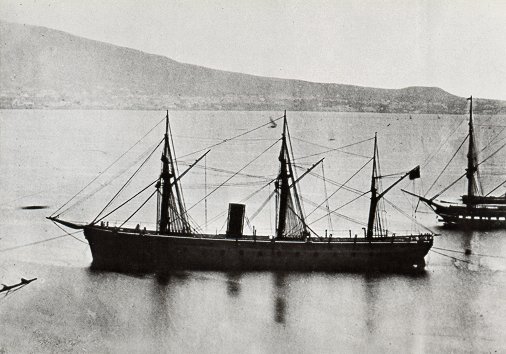
The Austro-Italian ironclad arms race
⚙ The naval Arms Race | |
 Regia Marina Regia Marina |  KuK Kriesgmarine KuK Kriesgmarine |
|
Formidabile class 1860 Principe di Carignano class 1861 Re d'Italia class 1861 Regina Maria Pia class (1862) Roma class (1863) Affondatore (1863) Principe Amedeo class (1864) |
Drache class (1860) Kaiser Max class (1861) Erzherzog Ferdinand Max class (1863) |
Following the unification of Italy in 1861, the newly formed Regia Marina was found itself in a de facto hot rivalry with Austria (soon unified also as an Empire) and an arms race started when Italy voted the acquisition of a fleet of ironclads just developed in order to bolster its meagre collection of former kingdom’s fleet’s ships of the line and steam frigates. At this point, the Austrian navy had nothing capable of facing ironclads. Italy wanted to expel the Austrian from what it considered its territories, notably Venice and Venetia at large, as a follow up of the unification wars. Italian shipyards were at that stage still incapable of building not only modern large steam frigates (Venice did) least so any ironclad. So the naval staff naturally turned to foreign yards, starting with the builders of Gloire, but the latter declined, being already full. In 1861 the class was named Re d’Italia and Portogallo after a consensus, and after seeing also wuth British yards, turned eventually to American shipyard William H. Webb.
Amazingly enough, US yards were pretty new to ironclads, only delivering much later (launched in May 1962) the USS New Ironsides at William Cramp & Sons, Philadelphia. This was thus a risky move. The project was under supervision of General Luigi Federico Menabrea, and the Italian Navy Minister. This design was based heavily on contemporary French ironclad Gloire, but no plans were provided of course, so it was only an interpretation of the design on what was known at the time; They had a wooden hull, a state of the art steam machinery, but in the end, they never meet the high expectations of the naval staff.
Re d’Italia was laid down on 21 November 1861, launched on 18 April 1863 and completed on 14 September 1864, whereas Re di Portogallo was laid down on December 1861, launched on 29 August 1863 and commissioned 23 August 1864. They were “fresh” when the war started.
Design of the class
Hull and general design
 The Re d’Italia class ironclads measured 83.82 meters (275 ft) between perpendiculars, 99.61 m (326 ft 10 in) overall at the tip of their bowsprit as their was a straight prow and add-on beak used for ramming. They had had a beam of 16.76 m (55 ft) and druaght was either 6.17 m (20 ft 3 in) for Re d’Italia, 7.18 m (23 ft 7 in) for Re di Portogallo. Displacement was 5,610 long tons (5,700 t) normal, 5,869 long tons (5,963 t) full load (Re di Portogallo 6,082 long tons/6,180 t). Due to emergency, they were built with unseasoned green wood and lacked under watertight compartments which will proved fatal at Lissa. Crews diverged, 565 for Re d’Italia and 552 for Re di Portogallo.
The Re d’Italia class ironclads measured 83.82 meters (275 ft) between perpendiculars, 99.61 m (326 ft 10 in) overall at the tip of their bowsprit as their was a straight prow and add-on beak used for ramming. They had had a beam of 16.76 m (55 ft) and druaght was either 6.17 m (20 ft 3 in) for Re d’Italia, 7.18 m (23 ft 7 in) for Re di Portogallo. Displacement was 5,610 long tons (5,700 t) normal, 5,869 long tons (5,963 t) full load (Re di Portogallo 6,082 long tons/6,180 t). Due to emergency, they were built with unseasoned green wood and lacked under watertight compartments which will proved fatal at Lissa. Crews diverged, 565 for Re d’Italia and 552 for Re di Portogallo.
Armour protection layout
Their wooden hulls were sheathed with wrought iron armor plating, just above the waterline, 120 mm thick. They also had bulkheads fore and aft of the mai battery deck, but their rudder and machinery were unprotected. And neither below the waterline. Surviving Re D’Italia was easy prey for modern shells.
Powerplant
Each had a single-expansion marine steam engine (recprocating, details uknown) driving a single four-bladed screw propeller. Steam came from four coal-fired rectangular fire-tube boilers provided by the yard. All exhausts were trunked into a single funnel. This output was 1,812 to 1,845 hp as indicated, providing a top speed of 10.6 to 10.8 knots (19.6 to 20.0 km/h; 12.2 to 12.4 mph), for a range of 1,800 nautical miles (3,300 km; 2,100 mi) at 10.5 knots (19.4 km/h; 12.1 mph), largely sufficient for the Adriatic. Single rudder, large, so they were relatively agile. They were barque rigged also for long range cruises with three masts and a sail area of 21,317 square feet (1,980.4 m2).
Armament
The Re d’Italia-class broadside ironclad’s main battery comprised six 72-pounder 203 mm (8 in) guns at the center of the battery, four each side, completed by sixteen (thirty-two total) 164 mm (6.5 in) rifled muzzle-loading guns (RML). Re di Portogallo diverged by having two larger 254 mm (10 in) RML guns and twenty-six 164 mm guns, all smoothbore. Their spur-shaped ram never had the occasion to serve, although Re di Portogallo tried. In 1870, surviving Re di Portogallo was rearmed with six 203 mm and twelve 164 mm guns but she retained two 10-in guns. In 1971 she became a gunnery training ship with twenty 203 mm guns, two 120 mm (4.7 in) guns, eight 80 mm (3.1 in) guns.
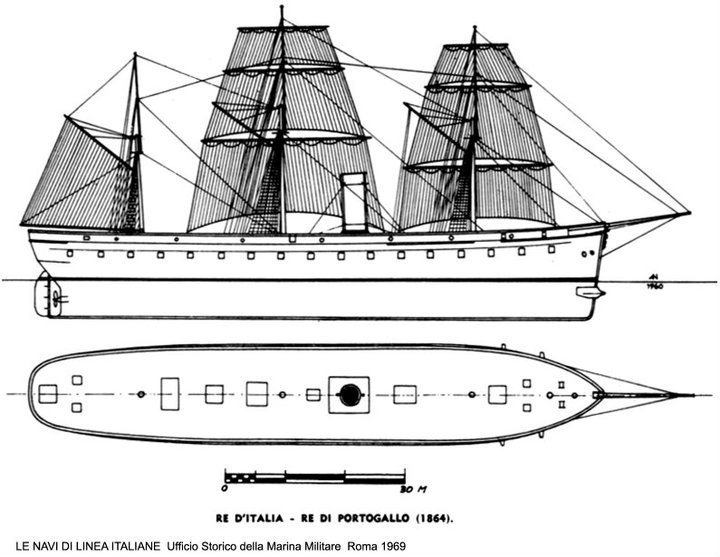
⚙ specifications |
|
| Displacement | 5,610 long tons (5,700 t) standard, 5,869 long tons (5,963 t) FL |
| Dimensions | 83.82pp/99.61oa x 16.76 x 6.17 (275 ft/326 ft 10 in x 55 ft x 20 ft 3 in) |
| Propulsion | 1 shaft Rec. steam eng., 4 FT boilers 1,812 to 1,845 ihp (1,351 to 1,376 kW) |
| Speed | 12 knots (22 km/h; 14 mph) also Barque-rigged |
| Range | 3,120 nmi (5,780 km; 3,590 mi) at 12 knots (22 km/h; 14 mph) |
| Armament | 30 × 164 mm (6.5 in) RML, 6 × 72-pounder 203 mm (8 in) SG |
| Protection | Belt 114 mm (4.5 in), Bulkheads 119 mm (4.7 in) |
| Crew | 565 |
Read More/Src
Books
Fraccaroli, Aldo (1979). “Italy”. In Gardiner, Robert (ed.). Conway’s All the World’s Fighting Ships 1860–1905. Conways
Greene, Jack; Massignani, Alessandro (1998). Ironclads at War: The Origin and Development of the Armored Warship, 1854–1891. Da Capo Press.
Ordovini, Aldo F.; Petronio, Fulvio & Sullivan, David M. (December 2014). “Capital Ships of the Royal Italian Navy, 1860–1918, Warship International 51
Silverstone, Paul H. (1984). Directory of the World’s Capital Ships. New York: Hippocrene Books.
Sondhaus, Lawrence (1994). The Naval Policy of Austria-Hungary, 1867–1918. West Lafayette: Purdue University Press.
Wilson, Herbert Wrigley (1896). Ironclads in Action: A Sketch of Naval Warfare from 1855 to 1895. London: S. Low, Marston and Company.
Links
marina.difesa.it
on en.wikipedia.org
on it.wikipedia.org/
Model Kits
3D
 Re d’Italia
Re d’Italia

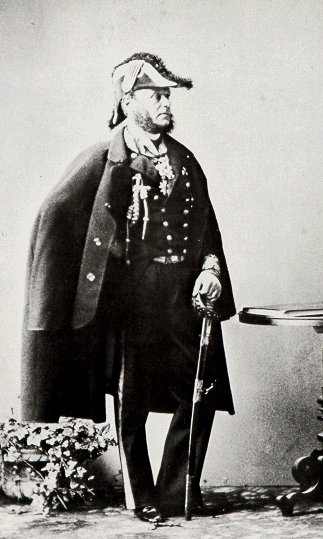 Re d’Italia arrived in Italy in April 1864, was commissioned on 18 September 1864 and by June 1866, Italy declared war on Austria (Third Italian War of Independence) and she became flagship of Admiral Carlo Pellion di Persano. When Rear Admiral Wilhelm von Tegetthoff sailed to Ancona on June 27 to draw out the Italians the latter were in disarray between training, armament or engines issues and not clear orders. Re d’Italia even had a fire in her coal bunkers. Persano was aboard Principe di Carignano to determine a course of action until urged by Minister of the Navy Agostino Depretis which suggested a landing on the island of Lissa to restore confidence after the defeat at Custoza. On 7 July, Persano a sweep in and out of Ancona until 13th.
Re d’Italia arrived in Italy in April 1864, was commissioned on 18 September 1864 and by June 1866, Italy declared war on Austria (Third Italian War of Independence) and she became flagship of Admiral Carlo Pellion di Persano. When Rear Admiral Wilhelm von Tegetthoff sailed to Ancona on June 27 to draw out the Italians the latter were in disarray between training, armament or engines issues and not clear orders. Re d’Italia even had a fire in her coal bunkers. Persano was aboard Principe di Carignano to determine a course of action until urged by Minister of the Navy Agostino Depretis which suggested a landing on the island of Lissa to restore confidence after the defeat at Custoza. On 7 July, Persano a sweep in and out of Ancona until 13th.
On 16 July the fleet sortied agains this time for Lissa, arriving the 18th with troop transports (3,000 men) and started bombarding Austrian forts when the Austrian Navy departed. His fleet could be caught “pants down” with just one of its three fleets ready to receive the attack. Re d’Italia was Persano’s flagship of the 2nd Division with San Martino and Palestro. The two other fleets were sent to bombard Vis, but no landing took place.
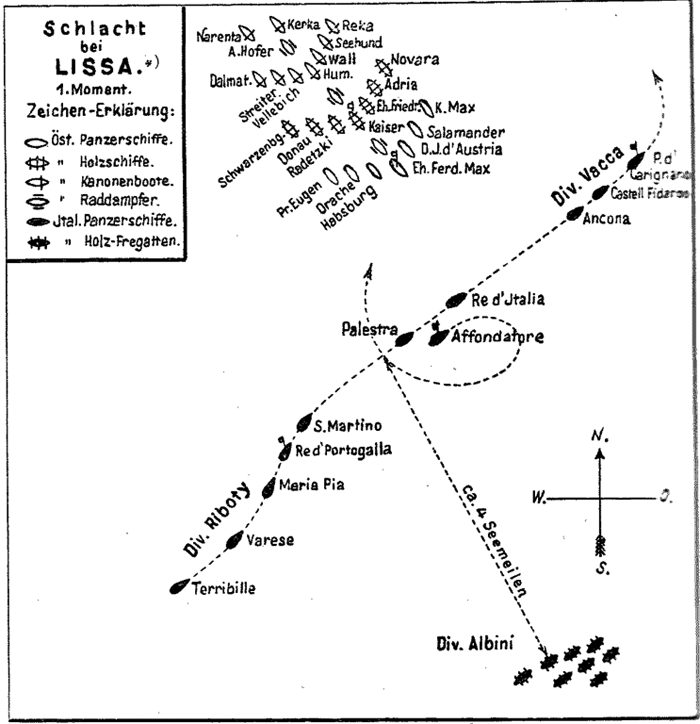
On the 20th, his fleet attacked the harbor defenses at Vis, Re d’Italia engaging the outer fortifications without success. Persano decided to make a third attack on the 21 but the Esploratore stayed in scree away spotted Tegetthoff’s fleet and prompted Persano to reorganized his three fleets. Admiral Giovanni Vacca’s 1st Division were three miles northeast from Persano with three more Ironclads further to the west. Persano wanted all his ships to catch up in a line abreast and then in line ahead formation, with Re d’Italia as fourth in line, behind Vacca’s ships.
Unexpectedly Persano decided to leave Re d’Italia for Affondatore just as Tegetthoff’s wedge arrived, breaking all command.
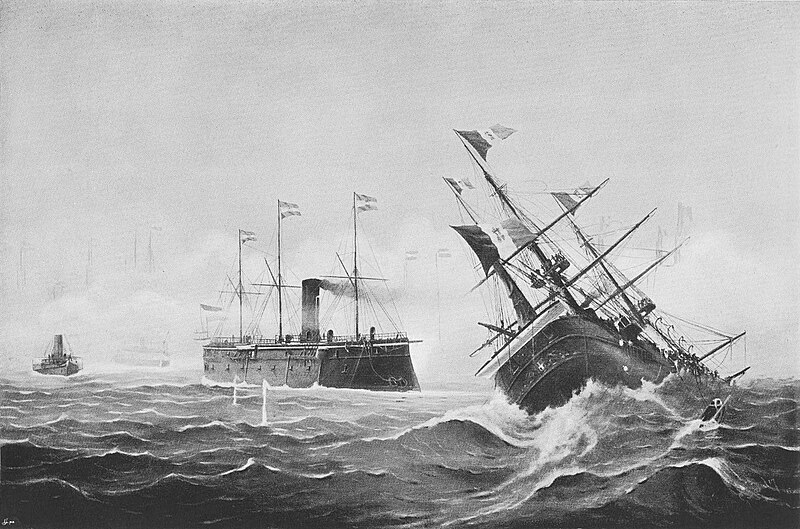
Re d’Italia was stopped also, leaving a growin gap in the formation, in which Tegetthoff went straight. He failed to ram any Italian vessel at fist, but soon a melee started. Re d’Italia, San Martino, and Palestro came under heavy fire, especially the first with much attention to her stern. She was rammed and lost her, lezaving her unable to manoeuver, until her captain, Emilio Faà di Bruno, attempted to escape until blocked by another Austrian ironclad, then tried to reverse course until rammed by Austrian flagship, Erzherzog Ferdinand Max. With a massive hole and no compartimentation, she rapidly filled like a bathub, rolled over to port and sank. Only 166 men survived, the rest went down including Captain Faà di Bruno.
 Re di Portogallo
Re di Portogallo
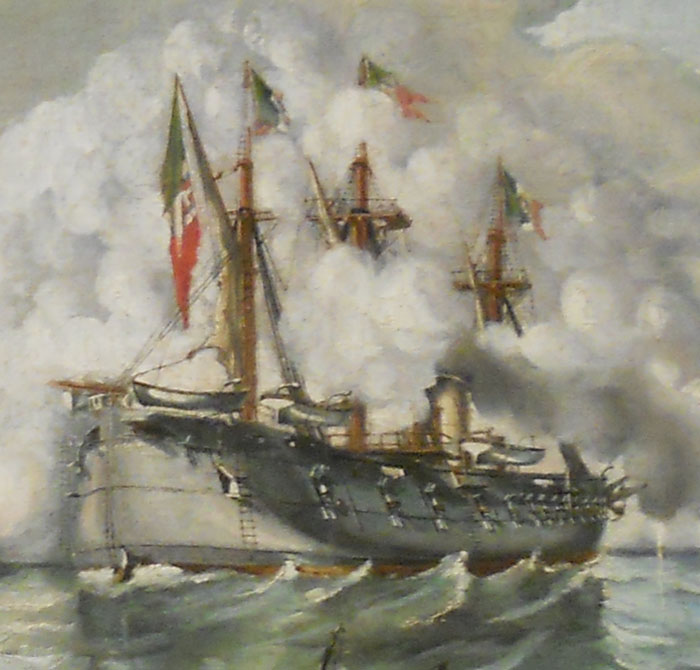
Re di Portogallo crossed the Atlantic and joined the Italian fleet after completion and after 1865 spent in training, by June 1866, the war started and she took her place under Admiral di Persano, and was found like her sister at the Battle of Lissa. Re di Portogallo initially attacked the Erzherzog Friedrich and Kaiserin Elizabeth until Kaiser (still a ship of the line) rammed Re di Portogallo to protect her sisters in the melee, despite having only her wooden bow as a ram. But the glancing blow caused only little damage and Re di Portogallo wrecked her decks with light guns, starting a fire and disabling many Austrian gunners. Kaiser escaped. Re d’Italia being lost, Palestro on fire and later exploding, Persano ordered to break off, refusing to counter-attack. They withdrew as the night began to fall for Ancona. Re di Portogallo was relatively unscathed with some iron plates to be repaired.
Vacca replaced Persano ousted by the ministry, and he was ordered to attack Pola when the war ended. Re di Portogallo was quickly repaired but saw little service as obsolete. In 1870, she was rearmed and again in 1871 to be converted into a gunnery training ship. In 1873, she was stationed in La Spezia. However her hull in unseasoned wood and original construction flaws had her placed in reserve, then stricken on 31 March 1875 and BU. The three Principe di Carignano-class were also discarded at the saome time as cost saving. It helped funding the brand new Duilio and Italia-classes.


 Latest Facebook Entry -
Latest Facebook Entry -  X(Tweeter) Naval Encyclopedia's deck archive
X(Tweeter) Naval Encyclopedia's deck archive Instagram (@navalencyc)
Instagram (@navalencyc)





 Austrian Navy
Austrian Navy French Navy
French Navy Royal Navy
Royal Navy Armada Espanola
Armada Espanola K.u.K. Kriegsmarine
K.u.K. Kriegsmarine Dansk Marine
Dansk Marine Nautiko Hellenon
Nautiko Hellenon Koninklije Marine 1870
Koninklije Marine 1870 Marinha do Brasil
Marinha do Brasil Osmanlı Donanması
Osmanlı Donanması Marina Do Peru
Marina Do Peru Marinha do Portugal
Marinha do Portugal Regia Marina 1870
Regia Marina 1870 Nihhon Kaigun 1870
Nihhon Kaigun 1870 Preußische Marine 1870
Preußische Marine 1870 Russkiy Flot 1870
Russkiy Flot 1870 Svenska marinen
Svenska marinen Søværnet
Søværnet Union Navy
Union Navy Confederate Navy
Confederate Navy Armada de Argentina
Armada de Argentina Imperial Chinese Navy
Imperial Chinese Navy Marinha do Portugal
Marinha do Portugal Mexico
Mexico Kaiserliche Marine
Kaiserliche Marine 1898 US Navy
1898 US Navy Russkiy Flot
Russkiy Flot French Naval Aviation
French Naval Aviation Russian Naval Aviation
Russian Naval Aviation Sovietskiy Flot
Sovietskiy Flot Royal Canadian Navy
Royal Canadian Navy Royal Australian Navy
Royal Australian Navy RNZN Fleet
RNZN Fleet Chinese Navy 1937
Chinese Navy 1937 Kriegsmarine
Kriegsmarine Chilean Navy
Chilean Navy Danish Navy
Danish Navy Finnish Navy
Finnish Navy Hellenic Navy
Hellenic Navy Polish Navy
Polish Navy Romanian Navy
Romanian Navy Turkish Navy
Turkish Navy Royal Yugoslav Navy
Royal Yugoslav Navy Royal Thai Navy
Royal Thai Navy Minor Navies
Minor Navies Albania
Albania Austria
Austria Belgium
Belgium Columbia
Columbia Costa Rica
Costa Rica Cuba
Cuba Czechoslovakia
Czechoslovakia Dominican Republic
Dominican Republic Haiti
Haiti Hungary
Hungary Honduras
Honduras Estonia
Estonia Iceland
Iceland Eire
Eire Equador
Equador Iran
Iran Iraq
Iraq Latvia
Latvia Liberia
Liberia Lithuania
Lithuania Mandchukuo
Mandchukuo Morocco
Morocco Nicaragua
Nicaragua Persia
Persia San Salvador
San Salvador Sarawak
Sarawak Uruguay
Uruguay Venezuela
Venezuela Zanzibar
Zanzibar Warsaw Pact Navies
Warsaw Pact Navies Bulgaria
Bulgaria Hungary
Hungary

 Bundesmarine
Bundesmarine Dutch Navy
Dutch Navy Hellenic Navy
Hellenic Navy Marina Militare
Marina Militare Taiwanese Navy
Taiwanese Navy Chinese Navy
Chinese Navy Indian Navy
Indian Navy Indonesian Navy
Indonesian Navy JMSDF
JMSDF North Korean Navy
North Korean Navy Philippines Navy
Philippines Navy ROKN
ROKN IDF Navy
IDF Navy Royal New Zealand Navy
Royal New Zealand Navy Egyptian Navy
Egyptian Navy South African Navy
South African Navy

































 RN
RN
 Marine Nationale
Marine Nationale
 Soviet Navy
Soviet Navy
 dbodesign
dbodesign